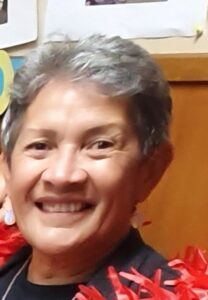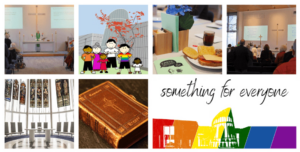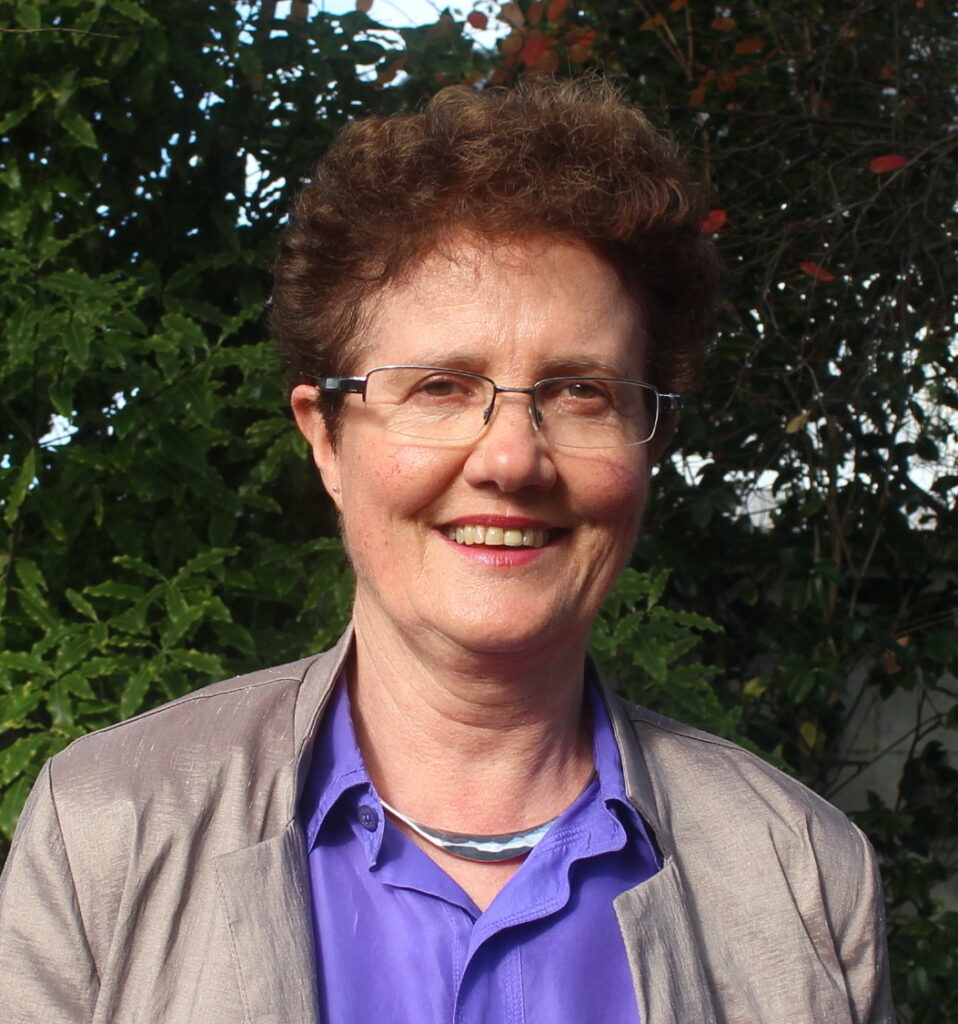
by Jane Simpson
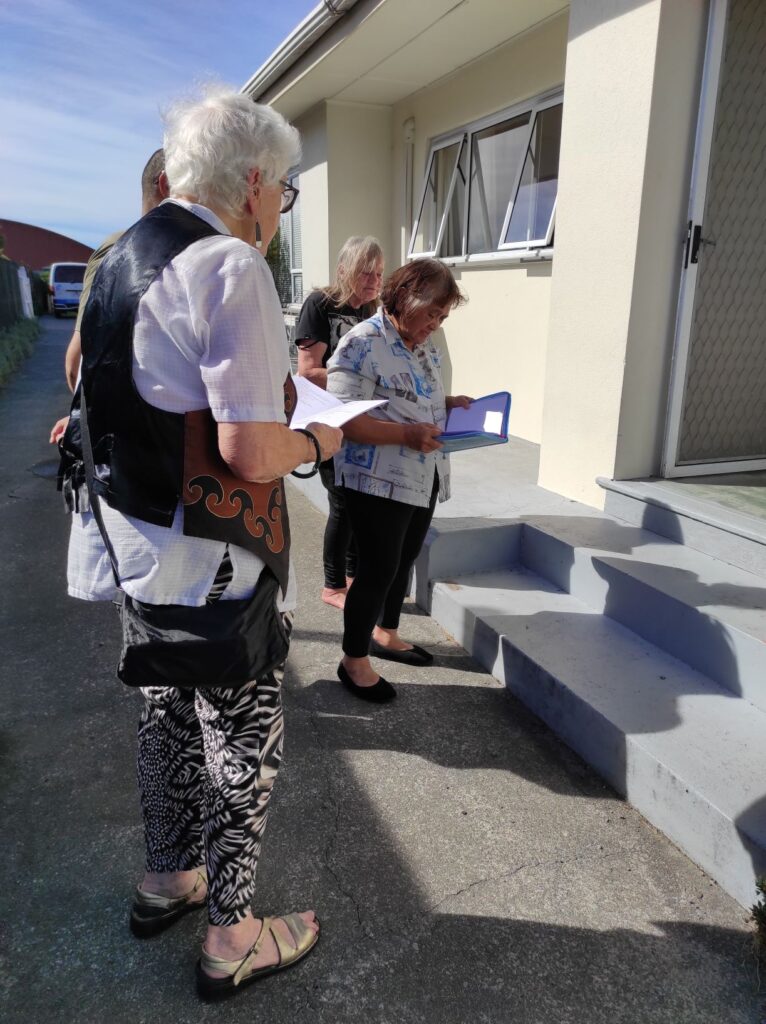
On Easter Monday a householder in Aranui, Christchurch, was sluicing down her front steps. In the sweltering heat they were dry in next to no time. The packing was done. The movers were coming the next day. Thirty minutes later a small group gathered at the entrance, each holding a copy of a new book
left: Prayer at the entrance

Their son, Wayne, had come down from Wellington to help with the packing and cleaning.The whānau were joined by two friends from the Diocesan Bicultural Education Committee, Marjorie Smart and Shirley Free, and by the author
left: Family group
When Rawinia had come to the launch of The Farewelling of a Home: a liturgy, in the Transitional Cathedral on 20 February, she never imagined she would be the first householder to use it. In humble beginnings, in an old state housing area, a liturgy was about to be used for the first time.
I had written the liturgy to be easily adapted and knew Rawinia wanted to make it her own, using all the parts in te reo Māori and adding karakia and waiata. As our small group gathered at the entrance, she recited ‘Te Whakinga Hara’ (the Collect for Purity). We moved straight to the galley kitchen where Ron had prepared dinner there for 4.30pm every day. Rawinia read the prayer which was already becoming a favourite:
Creator God, we give thanks this day
for cooking and conversation,
for family and friends, unexpected guests,
the fruit of the earth, the work of our hands,
for recipes passed down, new ones to test,
your kingdom like leaven in a lump of dough,
the mustard seed sown that becomes a great tree.
© Jane Simpson, The Farewelling of a Home: a liturgy. p.13
.

We went into the living room and Rawinia spoke about all the places she and Ron had lived; a map of their marriage. We sat down and Wayne read the prayer for that room. He was taken aback by the lines: ‘Here we have laughed and cried, argued and made up.’ Prayer could dare to be direct.
left: Rawinia in the living room
. After Rawinia shared her memories, an extraordinary feeling of peace settled on us, a deep wairua, a gentle spirit. It was palpable. Like a long marriage, there was no need to talk. From this sacred space, Rawinia and Ron would make their next house their home. There was a powerful sense of solidarity as we read the prayers of taking leave. The group sent Rawinia and Ron out. We left the house in silence. Rawinia closed the door for the last time.
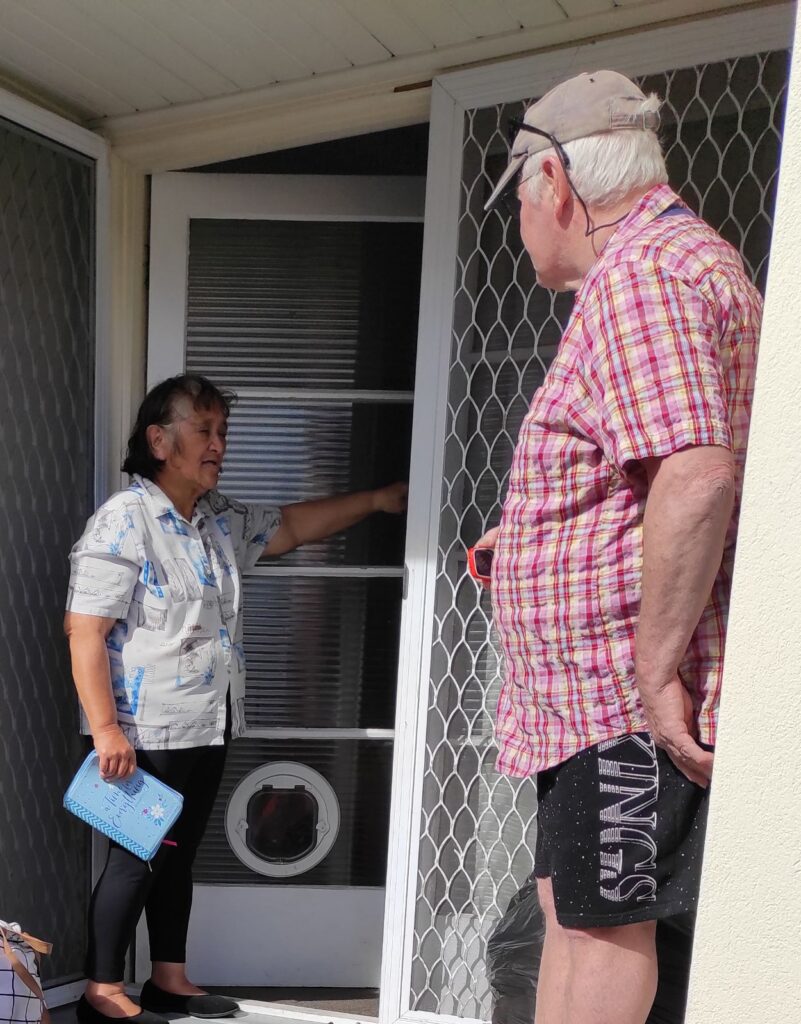
left: Rawinia closing the door for the last time
Why I had written The Farewelling of a Home?
See video of Jane describing her creation of this liturgy https://youtu.be/gyHbsQVCObc
I wrote the liturgy, in the first instance, in response to a need, an extreme need. Ten years earlier, on 22 February 2011, an immensely destructive earthquake struck Christchurch and its surrounding districts. In the city of 400,000 people, 100,000 homes were damaged or completely destroyed and 185 lives were lost. Whole suburbs were covered in liquefaction. People in the eastern suburbs who had lost their homes and who knew I was a poet asked me to help them. They wanted to go to the site, acknowledge their loss and to grieve, if possible, to go through the rooms and evoke memories, and to affirm together hope in the future. This was to become the structure of my liturgy.
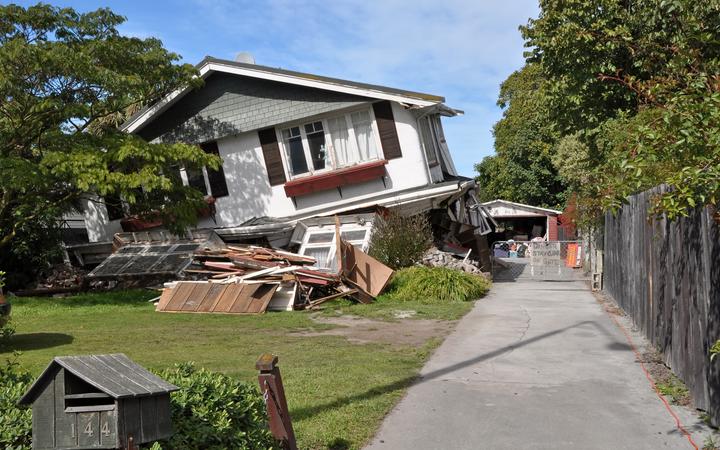
In the months that followed, some parishioners, including displaced elderly moving to a resthome, turned to their clergy and said they would like a service to farewell their home, to share memories and pray for the future. There was nothing in the liturgy books for this. A few priests known for their creative work in liturgy, like the Ven. Helen Roud, quickly put one together or even made one up on the spot. I have written about this in a major article published in 2020 in the Australian Journal of Liturgy, ‘Farewelling a Home: the difference an earthquake makes’. The whole article is downloadable from my website, www.poiema.co.nz/about.
The search for relevant liturgies
Looking back, I remembered I had helped my parents in 2000 farewell our family home liturgically. In retirement they wanted a smaller and newer house. The home that had served us for 42 years since arriving from the UK was almost certainly going to be demolished to make way for new townhouses. I felt we had to do something to mark its importance in our lives. As an Anglican, I knew the service of ‘The Blessing of a Home’ in A New Zealand Prayer Book = He Karakia Mihinare o Aotearoa (1989) and adapted it to farewell our home instead. I became a priest to my parents and assigned the parts to each. The house was almost completely empty, so spoke of finality. We placed a few precious things in each room as symbols to be collected up to provide a sense of continuity in my parents’ new home in their retirement. I thought nothing more of it till after the quakes.

As an Anglican, I knew the service of ‘The Blessing of a Home’ in A New Zealand Prayer Book = He Karakia Mihinare o Aotearoa (1989) and adapted it to farewell our home instead. I became a priest to my parents and assigned the parts to each. The house was almost completely empty, so spoke of finality. We placed a few precious things in each room as symbols to be collected up to provide a sense of continuity in my parents’ new home in their retirement. I thought nothing more of it till after the quakes.
If there was to be a liturgy to farewell a home, I saw it as being part of a living tradition, of the rich bicultural heritage of our Anglican Church in this country, as expressed in our Prayer Book. It has two pastoral liturgies to do with the home: ‘The Takahi Whare’, prayers in a house after death, and ‘The Blessing of a Home’. Both as a church historian and as a poet, I wanted to dig deeper into their origins and analyse their development. I produced two major articles, published in the Australian Journal of Liturgy. The Most Rev. David Moxon, author of ‘The Blessing of a Home’, generously shared his memories of writing it as a young priest. A number of points are relevant to farewelling a home. The Prayer Book editors chose to call the service the ‘Blessing of a Home’ because it connoted both the blessing of people, acceptable to Protestants, and of the physical house and things in it, associated with Catholicism. It was innovative on a number of counts: it used biblical and local imagery of nature, drew on Māori tradition but did not copy it slavishly, was highly poetic, and its language was inclusive on both the human and divine levels. It crossed barriers between low and high church by having flexible rubrics for symbolic action. Additional directions meant it could be adapted for use in a number of contexts, including a Eucharist and/or an informal shared meal.
As bush fires raged across vast swathes of Australia in January 2020, destroying thousands of homes, I scoured the literature for evidence of a ritual, service or liturgy of farewelling a home. A search of the secondary literature using standard methods found no particular instance or a general concept; nothing in the Hebrew scriptures, New Testament or Qur’an. Māori had no karakia to farewell a home. Jump to the 1990s and the American liturgist, Joyce Rupp, OSM, released a collection of rites of farewell in her Praying our goodbyes: understanding the spirituality of change in our lives (1992). Three were written for people at different stages of the separation process, but curiously not from within the context of having to leave their home. Human rites (1995), edited by British liturgists, Hannah Ward and Jennifer Wild, has a number of services of endings. A ‘Liturgy for the leave-taking of a house after separation or divorce’ by New Zealand Anglican priest, the Rev. Erice Fairbrother, is possibly the first of its kind. While liturgy books were silent, I found evidence of highly personal practices and rituals of farewell in biography and poetry.
Writing a liturgy from scratch

From the liturgies of endings collected in this search I gathered prayers and placed them into a proposed structure for the new liturgy: I. Gather, II. Acknowledging Loss (Lament), III. Giving Thanks for the Past, IV. Taking Leave and V. The Blessing and Sending Out. At that stage I imagined producing a compilation of resources for a liturgy, a collection of other people’s prayers. It wasn’t working. A moment of illumination came on the first leg of a cycling holiday from Invercargill to Dunedin via the Catlins, on a bitterly cold day hemmed in by low cloud as I headed to Fortrose. Suddenly light streamed onto a distant hillock. It was perfectly formed and covered in vibrant colours. At that instant there was an inner illumination: I had to write the liturgy from scratch. From that moment I never doubted my ability to undertake and complete the task.
Writing the liturgy as a poet
Few established poets write prayers; even fewer write liturgies. Very few writers of liturgy are established poets. The poems in my first poetry book, Candlewick Kelp (2000), created unusual images and used sound and word play. My CD hymns and songs released in 2002, Tussocks Dancing, uses concrete imagery rather than the abstract nouns that tend to dominate contemporary hymnody. Drawing on my teaching of feminist theology as a university lecturer in Religious Studies, I wrote hymns with seldom-used feminine biblical images of God. My first full length poetry collection, A world without maps (2016), came out of my time teaching Muslim women teachers English in a desert school in Abu Dhabi, where my ideas about Muslim women were completely shattered. Tuning Wordsworth’s Piano (2019) was based on an unlikely pilgrimage to Hone Tuwhare’s unmarked crib on a cycling holiday. The final section has poems with strongly theological and feminist themes.
I decided to write ‘The Farewelling of a Home’ as if I was putting a poetry collection together. Seeing how two poems facing each other start up a conversation is always fascinating. Two very different styles of writing can be juxtaposed, which is less likely to happen if the liturgy is being written by a committee. The first prayer after an earthquake is a very simple lament, almost in a child’s voice. It is followed by a beautifully written collect by our then Assistant Priest at the Transitional Cathedral, the Rev. Ben Randall. The Rt. Rev. Brian Carrell wrote a prayer for the litany through the rooms, which was translated into te reo Māori.
The liturgy also had to work as a sequence of prayers said in space, as the group moved through the house. Clear rubrics were required, written with almost legal precision. There were no models for rubrics if a house couldn’t be entered, in this case because it had been damaged in a natural disaster. Once again, I am indebted to Ben Randall for providing the necessary clarity.
A single phrase in the first prayer in I. Acknowledging Loss (Lament) became the key to unlocking the whole liturgy. One of my students was a Filipina factory worker who lived in Wainoni and worked on the other side of Christchurch. I taught Gloria English under the government-funded Workplace Literacy Scheme. The first lesson after the quake she vividly described the shaking and having to dive under her worktable. Her boss had rung the next day and insisted she go to work. Her response was simple: ‘Sir, my house is broken.’ This is the unconscious poetry of young children, of people who speak English as a second language. Her simple response to an unreasonable employer was also her lament for a broken city. I wrote:
O God who weeps
our house is broken
our hearts are broken
our home is no more. (p.7)
Getting the liturgy published
I was very fortunate in that the Editor of the Australian Journal of Liturgy, Dr Angela McCarthy, had accepted my article about the need for a rite of farewelling a home even before I submitted it. If I were to write a liturgy based on this research, would she be interested in publishing it? I hoped it would appear together with the article. The AJL seldom published whole liturgies, but she would send both off for peer review. Since this could be my first published liturgy, I looked forward to full critical scrutiny. The use of feminine images of God as Wisdom, as Mother, was not questioned. Versions of the responses in reo Māori were added, including Brian Carrell’s prayer for the litany in the rooms.
A liturgy in an academic journal is a liturgy locked up. Since the AJL was not online, the relevant pages would need to be interloaned by anyone wanting to use the liturgy. Copying the whole liturgy would infringe copyright. Each time there was news of floods inundating houses, bush fires destroying them, of a woman having to flee a violent relationship, I felt powerless. My liturgy had to be in people’s hands. The Board of the Australian Academy of Liturgy had already given me permission to publish it as a book. With practically no capital, I set up my own press, Poiema Liturgies. As this was my first book as a publisher it had to be designed and produced to the highest possible standards. I was delighted when leading abstract painter, Gretchen Albrecht, gave me permission to use her wonderful painting, ‘Golden Vapour Cloud’ (1973) on the cover. Starting with this book, the intention is to publish more liturgies, crafted through poetry, to draw people both in and outside the churches.
Becoming an official liturgy
When I wrote The Farewelling of a Home I did so as an independent historian and liturgist. I had no intention of it receiving official sanction or the imprimatur of a committee. The Editor of Tāonga was interested in running a story but thought the liturgy should first have the backing of the Common Life Liturgical Commission. The Rt. Rev. George Connor, with whom I had corresponded on matters liturgical for five years, sent it to the CLLC. I hoped the Commission would be open to new things rooted in the Anglican tradition. The next step was for the Tikanga Pākehā Liturgical Working Group to look at it carefully with the idea of recommending it as a resource particularly in urban settings, rather than rural. I was delighted at the launch on 20 February when my bishop, the Rev. Dr Peter Carrell said: ‘Most church liturgies are composed by committees, with varying results, and there is room for an individual to produce a liturgy that both meets a need and gains wide acceptance. Your liturgy meets a need and I hope it gains wide acceptance. In due course, and through formal process it could be that your liturgy is accepted as an official liturgy of our church.’
Our dreams
My dream is that every parish has a set of five copies which can be lent out each time a home is farewelled. This could start with the Anglican Church in New Zealand, then be taken up in Australia, the UK, US and Canada and other English-speaking countries. To encourage bishops to order enough copies for all parishes and ministry units in their dioceses, the book is half-price when buying in bulk. I see parishes extending their pastoral ministry by offering the liturgy to their own parishioners and their neighbours about to move house. I hope that a version in te reo Māori will be available in due course. Wider than the Anglican Church, I envisage other churches throughout the world with strong liturgical traditions taking it up.
I leave the final word to Rawinia: ‘After the launch Jane’s beautiful liturgy was swirling around in my mind. I felt the service was lovely and done in a relaxed fashion. All six of us in the group had a part. I feel we six are all pioneers in our use of such a brilliant liturgy for the first time of many thousand more times to come all around the world! All the praise and thanks to God!’
Copies of The Farewelling of a Home
are available through Poiema Liturgies at https://www.poiema.co.nz/shop
Works cited by the author
The Farewelling of a Home: a liturgy, Christchurch, Poiema Liturgies, 2021.
‘Farewelling a home: the difference an earthquake makes,’ The Australian Journal of Liturgy,vol.17 no.1 (2020), pp.19–44.
‘The Blessing of a Home in New Zealand: origins and development,’ Australian Journal of Liturgy, vol.16 no.1 (2018), pp.4–19.
‘Prayers in a house after death: the Takahi Whare and the question of evidence,’ Australian Journal of Liturgy, vol.15 no.2 (2016), pp.86–107.
Candlewick Kelp, poems by Jane Simpson, Christchurch, Poets’ Group, 2002.
Tussocks Dancing: Hymns and Songs by Jane Simpson, Christchurch, Godzone Hymns, 2002.
© Jane Simpson (2021)
